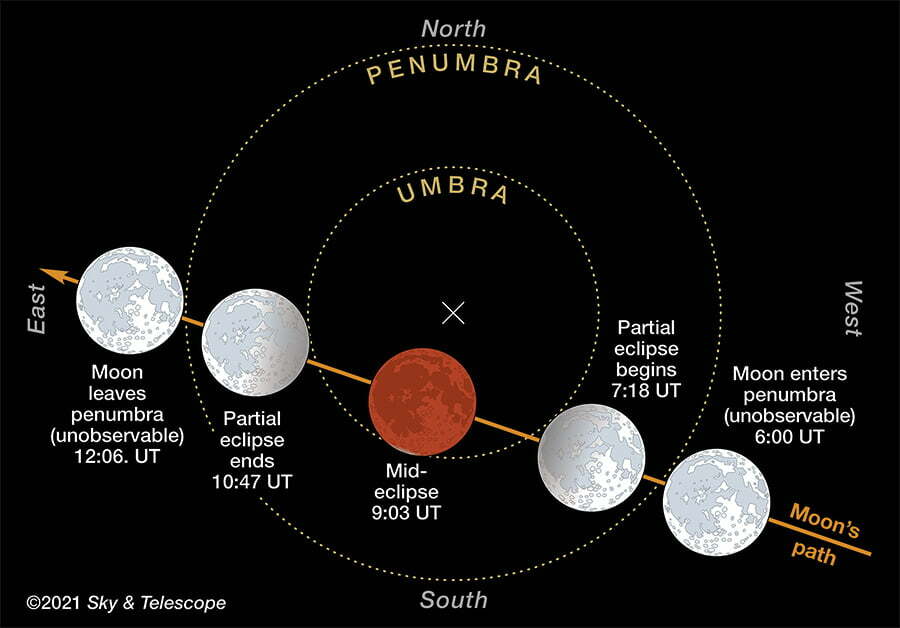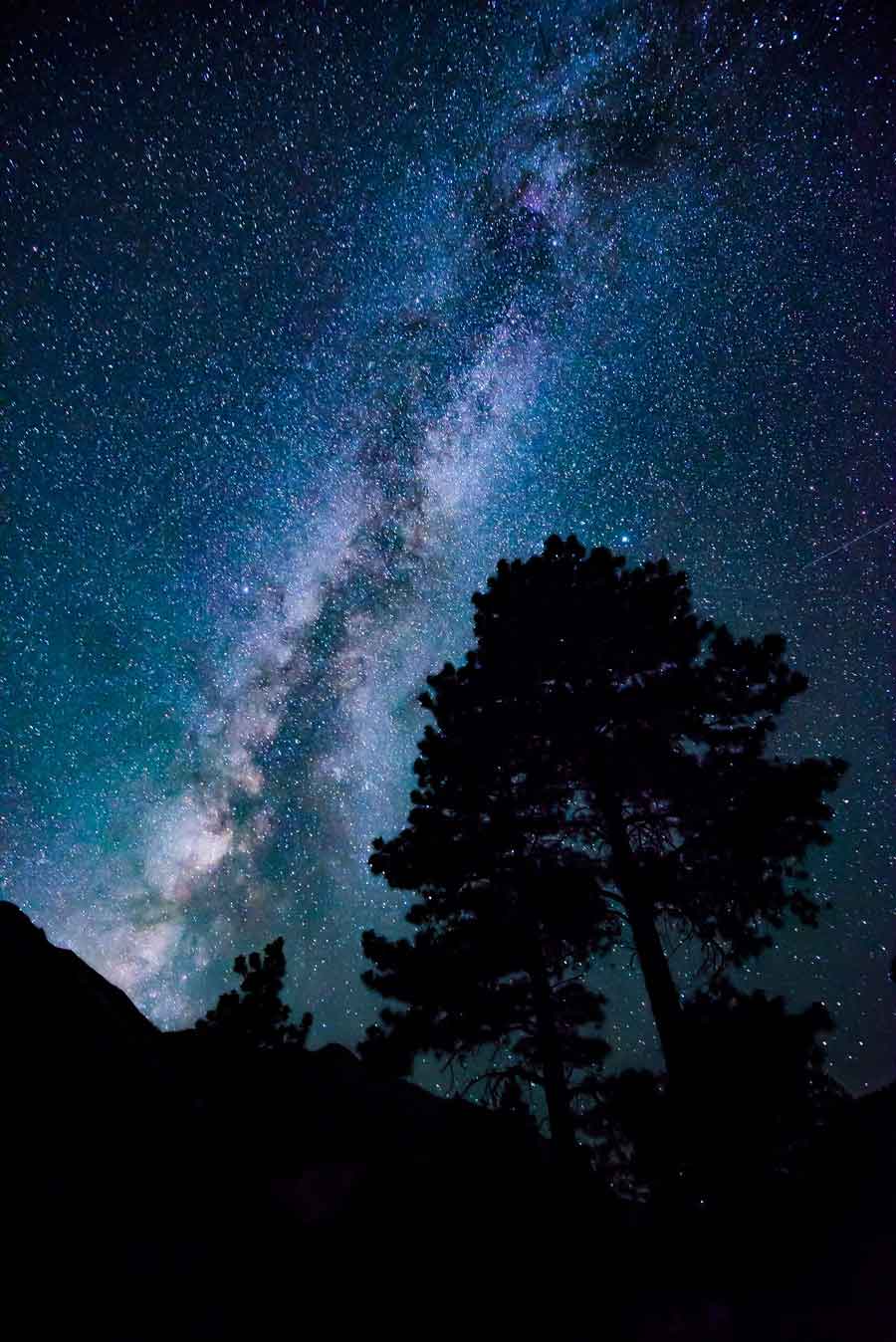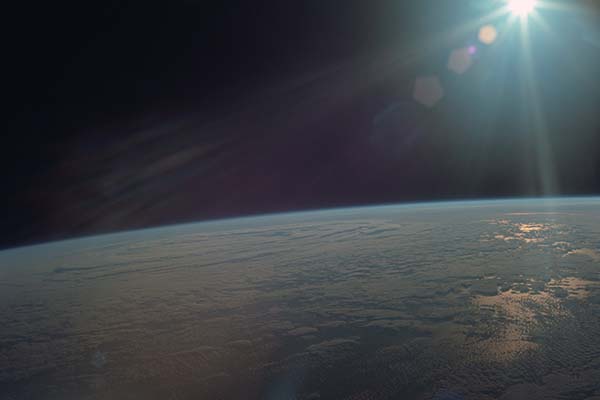North America Favored for This Week’s Deep Partial Lunar Eclipse
[ad_1]
Contacts:
Diana Hannikainen, Observing Editor, Sky & Telescope
+1 617-500-6793 x22100, diana@skyandtelescope.org
Gary Seronik, Consulting Editor, Sky & Telescope
gseronik@skyandtelescope.org
Susanna Kohler, Communications Manager and Press Officer, American Astronomical Society
+1 202-328-2010 x127, susanna.kohler@aas.org
Note to Editors/Producers: This release is accompanied by high-quality graphics; see the end of this release for the images and links to download.
Very late Friday night and early Saturday morning, you have a chance to watch the Moon darken and turn a reddish hue as it slips into Earth’s shadow. However, unlike the total lunar eclipse on May 26th this year, the November 18–19 event is a partial eclipse. But it’s a very deep one: About 97% of the Moon’s disk will pass through the umbra — the dark inner part of Earth’s shadow — leaving a tiny, silvery sliver of the Moon’s southern edge peeking out.
Weather permitting, viewers across almost all of North America will witness the entirety of the event. November’s eclipse favors night owls and early risers, because the full Moon passes through the umbra after midnight on November 19th for the four main U.S. time zones, and mid-eclipse occurs in the wee hours of the morning (at 4:03 a.m. EST and 1:03 a.m. PST). For Hawai’i and Alaska, the event starts to unfold before midnight.
Northeasternmost Asia will also see the entire event. In South America the eclipse happens as dawn is brightening, while for most of Australia the Moon will already be eclipsed as it rises. Much of western Europe should see the early penumbral stages before the Moon dips below the horizon.
What to Look For
The partial eclipse is predicted to last longer than usual, nearly 3½ hours. In fact, not only will it be the longest partial lunar eclipse this century, it’s also the longest partial lunar eclipse between February 18, 1440, and February 8, 2669. It happens 1.7 days before the Moon reaches its apogee, or the farthest point from Earth, in its orbit. This means that the Moon’s orbital motion will be slower, thereby increasing the duration of the event.
“The Moon will be in Taurus and pleasingly placed some 6° — approximately the width of three fingers held together at arm’s length — lower left of the pretty Pleiades open star cluster at the time of maximum eclipse,” says Diana Hannikainen (pronounced HUHN-ih-KY-nen), observing editor at Sky & Telescope. “This should provide great opportunities for some fun photos.”
The stages of the eclipse occur simultaneously for everyone who can see the Moon, but the actual clock times depend on your time zone. See the table below and diagrams at the end for times of key events for the lunar eclipse:
| Eclipse Event | UT | AST | EST | CST | MST | PST | AKST | HST |
| Penumbra first visible | 6:00 | 2:00 a.m. | 1:00 a.m. | 12:00 a.m. | *11:00 p.m. | *10:00 p.m. | *9:00 p.m. | *8:00 p.m. |
| Partial eclipse begins | 7:18 | 3:18 a.m. | 2:18 a.m. | 1:18 a.m. | 12:18 a.m. | *11:18 p.m. | *10:18 p.m. | *9:18 p.m. |
| Maximum eclipse | 9:03 | 5:03 a.m. | 4:03 a.m. | 3:03 a.m. | 2:03 a.m. | 1:03 a.m. | 12:03 a.m. | *11:03 p.m. |
| Partial eclipse ends | 10:47 | 6:47 a.m. | 5:47 a.m. | 4:47 a.m. | 3:47 a.m. | 2:47 a.m. | 1:47 a.m. | 12:47 a.m. |
| Penumbra last visible | 12:06 | — | 7:06 a.m. | 6:06 a.m. | 5:06 a.m. | 4:06 a.m. | 3:06 a.m. | 2:06 a.m. |
Mechanics of a Lunar Eclipse
A lunar eclipse happens when the Sun, Earth, and a full Moon form a near-perfect lineup in space, in what is known as syzygy. The Moon gradually glides into Earth’s shadow, until most of the lunar disk turns from silvery grey to an eerie dim orange or red. Then events unfold in reverse order, until the Moon returns to full brilliance.
The events that happen during a total lunar eclipse are more complex and interesting than many people realize. The eclipse occurs in five stages, each with different things to watch.
(1) The Moon’s leading edge enters the pale outer fringe of Earth’s shadow: the penumbra. You probably won’t notice anything until the Moon is about halfway across the penumbra. Watch for a slight darkening on the Moon’s leading edge. The penumbral shading becomes stronger as the Moon moves deeper in.
The penumbra is the region where an astronaut standing on the Moon would see Earth covering only part of the Sun’s disk.
(2) The Moon’s leading edge enters the umbra, the cone of Earth’s shadow within which the Sun’s completely hidden. You should notice a dramatic darkening on the upper left edge of the lunar disk as seen from North America. With a telescope, you can watch the edge of the umbra slowly engulfing one lunar feature after another, as the entire sky begins to grow darker.
(3) The trailing edge of the Moon slips into the umbra for the beginning of maximum eclipse. The Moon will glow some shade of coppery red or burnt orange.
Why is this? The Earth’s atmosphere scatters and bends (refracts) sunlight that skims its edges, diverting some of it onto the eclipsed Moon. It’s the same effect that happens at sunset. If you were on the Moon during a lunar eclipse, you’d see the Sun hidden by a dark Earth rimmed with the reddish light of all the sunrises and sunsets ringing the world at that moment.
The red umbral glow can be quite different from one eclipse to the next. Two main factors affect its brightness and hue. The first is simply how deeply the Moon goes into the umbra as it passes through; the center of the umbra is darker than its edges. The other factor is the state of Earth’s atmosphere. If a major volcanic eruption has recently polluted the stratosphere with thin global haze, a lunar eclipse can be dark red, ashen brown, or occasionally almost black.
In addition, blue light is refracted through Earth’s clear, ozone-rich upper atmosphere, above the thicker layers that produce the red sunrise-sunset colors. This ozone-blue light tints the Moon also, especially near the umbra’s edge, but you’ll need binoculars or a telescope to see this effect.
During this deep partial, a sliver of the southern edge of the Moon’s disk will shine brightly even at mid-eclipse.
(4) As the Moon continues moving along its orbit, events replay in reverse order. The sliver of light will grow and expand upwards along the Moon’s leading edge.
(5) When all of the Moon escapes the umbra, only the last, penumbral shading is left. Some time later, nothing unusual will remain visible.
“You only need your eyes to see the drama unfold, but if you have binoculars or a backyard telescope, they’ll give a much-enhanced view,” says Hannikainen.
Read more on this eclipse in the November 2021 issue of Sky & Telescope and on S&T‘s website: A Near-Miss Total Lunar Eclipse.
If it’s cloudy where you are, you can follow a live stream of the eclipse on the Virtual Telescope website starting at 7:00 UT on November 19th.
Sky & Telescope is making the illustrations below available to editors and producers. Permission is granted for nonexclusive use in print and broadcast media, as long as appropriate credits (as noted) are included. Web publication must include a link to skyandtelescope.org.

Gregg Dinderman / Sky & Telescope; Source: USNO

Gregg Dinderman / Sky & Telescope; Source: USNO

Sky & Telescope
Sky & Telescope

Bob King
For skywatching information and astronomy news, visit SkyandTelescope.org or pick up Sky & Telescope magazine, the essential guide to astronomy since 1941. Sky & Telescope and SkyandTelescope.org are published by the American Astronomical Society, along with SkyWatch (an annual beginner’s guide to the night sky) as well as books, star atlases, posters, prints, globes, apps, and other products for astronomy enthusiasts.
The American Astronomical Society (AAS), established in 1899, is a major international organization of professional astronomers, astronomy educators, and amateur astronomers. Its membership of approximately 8,000 also includes physicists, geologists, engineers, and others whose interests lie within the broad spectrum of subjects now comprising the astronomical sciences. The mission of the AAS is to enhance and share humanity’s scientific understanding of the universe as a diverse and inclusive astronomical community, which it achieves through publishing, meetings, science advocacy, education and outreach, and training and professional development.
[ad_2]
Original Post






I’m still learning from you, as I’m making my way to the top as well. I certainly liked reading everything that is posted on your website.Keep the stories coming. I liked it!
you’ve an incredible weblog here! would you like to make some invite posts on my blog?
Real good info can be found on website.
I am really loving the theme/design of your site. Do you ever run into any internet browser compatibility problems? A few of my blog audience have complained about my site not working correctly in Explorer but looks great in Safari. Do you have any tips to help fix this issue?
I really appreciate this post. I?¦ve been looking everywhere for this! Thank goodness I found it on Bing. You’ve made my day! Thank you again
Appreciating the hard work you put into your blog and in depth information you offer. It’s nice to come across a blog every once in a while that isn’t the same old rehashed material. Fantastic read! I’ve bookmarked your site and I’m including your RSS feeds to my Google account.
Hi my loved one! I wish to say that this post is awesome, great written and come with approximately all significant infos. I would like to see extra posts like this .
I don’t even know how I ended up here, but I thought this post was great. I don’t know who you are but certainly you’re going to a famous blogger if you aren’t already 😉 Cheers!
I will right away grab your rss feed as I can’t find your e-mail subscription link or newsletter service. Do you’ve any? Kindly let me know in order that I could subscribe. Thanks.
Cool blog! Is your theme custom made or did you download it from somewhere? A design like yours with a few simple tweeks would really make my blog jump out. Please let me know where you got your design. Appreciate it
I just couldn’t leave your web site before suggesting that I actually enjoyed the usual info an individual provide for your visitors? Is going to be again continuously to investigate cross-check new posts
I’m often to running a blog and i really admire your content. The article has really peaks my interest. I’m going to bookmark your site and preserve checking for new information.
I like what you guys are up too. Such intelligent work and reporting! Keep up the excellent works guys I have incorporated you guys to my blogroll. I think it’ll improve the value of my website 🙂
Hello there! Do you know if they make any plugins to assist with SEO? I’m trying to get my blog to rank for some targeted keywords but I’m not seeing very good results. If you know of any please share. Many thanks!
I believe that is among the so much vital info for me. And i am happy studying your article. However wanna statement on some basic things, The website taste is great, the articles is really excellent : D. Excellent activity, cheers
I consider something truly special in this site.
It’s a shame you don’t have a donate button! I’d certainly donate to this outstanding blog! I suppose for now i’ll settle for book-marking and adding your RSS feed to my Google account. I look forward to fresh updates and will talk about this website with my Facebook group. Talk soon!
hi!,I love your writing very much! proportion we keep up a correspondence extra about your article on AOL? I need an expert in this house to unravel my problem. May be that is you! Having a look forward to see you.
Thank you for the sensible critique. Me & my neighbor were just preparing to do a little research about this. We got a grab a book from our local library but I think I learned more from this post. I am very glad to see such wonderful info being shared freely out there.
I discovered your blog site on google and check a few of your early posts. Continue to keep up the very good operate. I just additional up your RSS feed to my MSN News Reader. Seeking forward to reading more from you later on!…
I was very pleased to seek out this web-site.I wished to thanks on your time for this wonderful learn!! I positively having fun with each little bit of it and I’ve you bookmarked to take a look at new stuff you blog post.
I like what you guys are usually up too. Such clever work and coverage! Keep up the awesome works guys I’ve included you guys to blogroll.
I and also my buddies happened to be analyzing the best key points on the website and so instantly got a terrible suspicion I had not thanked you for those techniques. Those women were so warmed to see all of them and now have truly been using those things. Appreciate your indeed being considerably helpful and for making a decision on these kinds of good topics millions of individuals are really needing to discover. My very own honest apologies for not saying thanks to earlier.
Great blog! Is your theme custom made or did you download it from somewhere? A theme like yours with a few simple adjustements would really make my blog shine. Please let me know where you got your theme. Thanks a lot
Regards for this marvelous post, I am glad I detected this site on yahoo.
Good – I should definitely pronounce, impressed with your website. I had no trouble navigating through all tabs and related info ended up being truly easy to do to access. I recently found what I hoped for before you know it at all. Quite unusual. Is likely to appreciate it for those who add forums or something, website theme . a tones way for your customer to communicate. Excellent task..
Hi, i believe that i saw you visited my site thus i came to “return the favor”.I am trying to in finding things to enhance my web site!I suppose its adequate to use some of your concepts!!
You have brought up a very wonderful points, appreciate it for the post.
Thank you for sharing superb informations. Your site is so cool. I’m impressed by the details that you?¦ve on this website. It reveals how nicely you understand this subject. Bookmarked this website page, will come back for extra articles. You, my pal, ROCK! I found simply the info I already searched everywhere and just couldn’t come across. What a great web-site.
Greetings! Very helpful advice on this article! It is the little changes that make the biggest changes. Thanks a lot for sharing!
What i don’t realize is in truth how you’re not actually much more smartly-liked than you may be now. You’re so intelligent. You recognize thus significantly when it comes to this topic, produced me in my view believe it from a lot of various angles. Its like men and women are not involved unless it’s something to accomplish with Girl gaga! Your personal stuffs nice. At all times take care of it up!
I’ve been absent for a while, but now I remember why I used to love this site. Thank you, I will try and check back more often. How frequently you update your web site?
Definitely believe that which you said. Your favorite reason seemed to be on the internet the easiest thing to be aware of. I say to you, I definitely get irked while people think about worries that they plainly don’t know about. You managed to hit the nail upon the top and also defined out the whole thing without having side-effects , people could take a signal. Will likely be back to get more. Thanks
Hmm it seems like your blog ate my first comment (it was extremely long) so I guess I’ll just sum it up what I submitted and say, I’m thoroughly enjoying your blog. I as well am an aspiring blog writer but I’m still new to the whole thing. Do you have any suggestions for beginner blog writers? I’d really appreciate it.